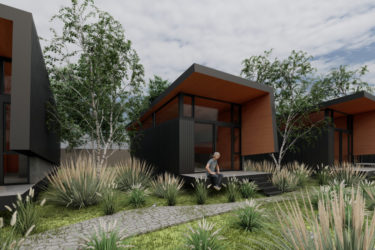
The tiny home movement in Geelong has received an extra push from a collaboration between Deaking University, Geelong company Formflow and Samaritan House that aims to achieve greater affordability for homeowners and people in need of transitional housing.
While unclear exactly what pushed the tiny home movement to pick up as it has, the increasing issues with housing affordability is a working theory. With a market that has effectively locked younger generations out of even hoping to achieve the Australian dream of a three bedroom house with a two car garage with advice provided like “stop eating avocados” it’s no wonder architecture students from Deakin University are looking at other solutions.
Story continues below advertisement
Through a local partnership Deakin University, Geelong technology company FormFlow and short-term accommodation provider Samaritan House Geelong, has developed a prototype, prefabricated, one-bedroom unit called Prefab21. Unlike most tiny homes however, this is one is more than just a glorified travel trailer and instead a home that is comfortable, sustainable and affordable.
Professor James Doerfler from Deakin’s School of Architecture and Built Environment stated that Prefab21 is a project that exceed on its original goals creating a house that ‘draws on sustainable design principles using strong, durable recyclable materials’.
Story continues below advertisement
“Importantly, the project also helps position Geelong at the forefront of sustainable, smart and efficient advanced manufacturing, and demonstrates our commitment as a globally recognised City of Design to the community’s clever and creative vision,” Professor Doerfler said.
Measuring 4m by 10m, Prefab 21 comprises a living space, bedroom and bathroom and is the first of seven living units to be installed by Samaritan House Geelong as transitional accommodation for men who have experienced homelessness. Samaritan House Geelong Board Member Brian Sherwell said the project is an innovative response to the shortage of affordable rental accommodation for single homeless men in Geelong.
Story continues below advertisement
Window positions and high ceilings give the house a sense of spaciousness to ensure occupants don’t feel boxed in. FormFlow COO Bernard Brussow said that PreFab21 has wide potential and sees it being used as emergency accommodation following natural disasters such as bushfires or earthquakes. Its modularity means it can be expanded upon which, while taking the tiny out of this tiny house, would allow it to accommodate growing families.
“The project has allowed us to demonstrate how next-generation design and manufacturing offer a new way of thinking about 21st century housing,” Professor Doerfler said.
If you loved this, we think you’d might like ‘Can we make this an opportunity to be better than ever?‘